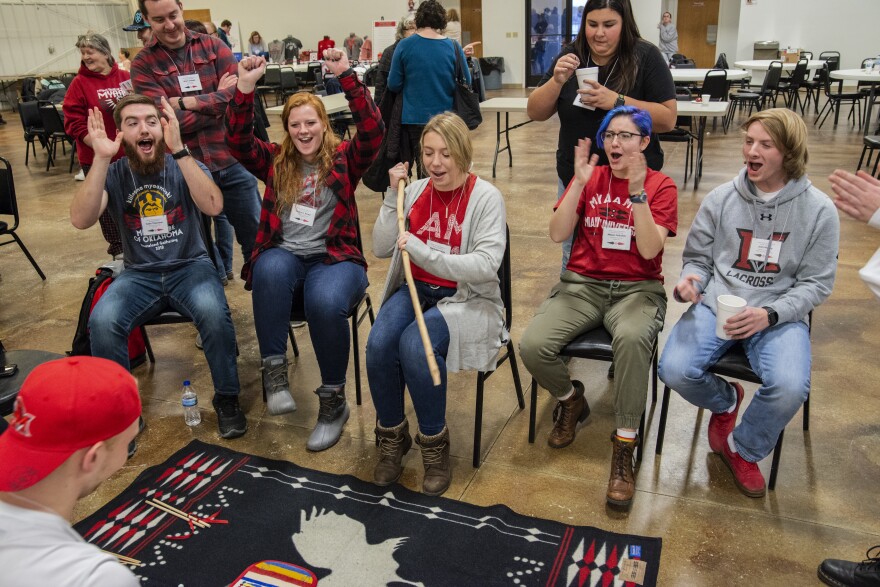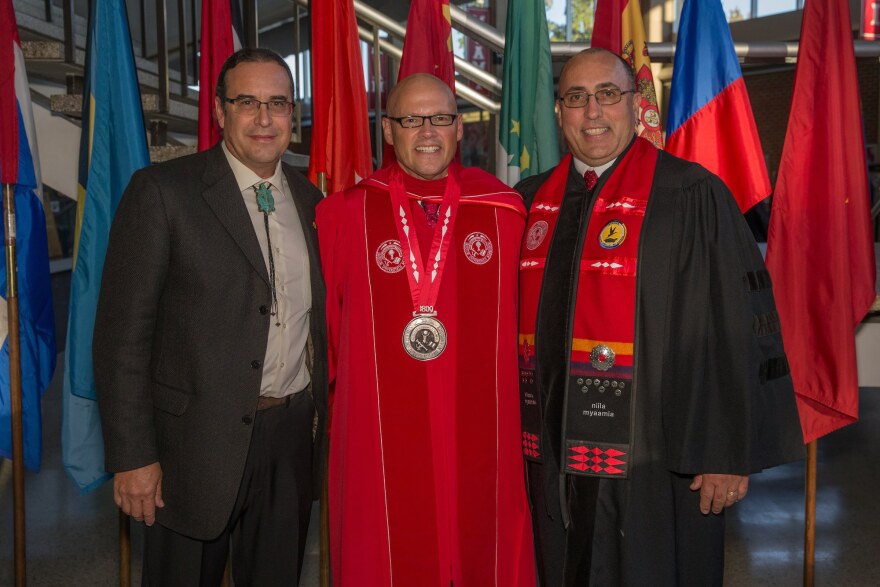More than two decades before this month's announcements from a Cincinnati-area high school and the Washington D.C. NFL team, Miami University's Board of Trustees voted to drop a controversial, race-based nickname and mascot. The Miami Tribe of Oklahoma and Miami University are taking a moment now to talk about that decision.
Kara Strass is director of tribe relations for the Myaamia Center, a partnership between the university and the tribe to promote the Myaamia (Miami) language and culture through research, education and outreach. While the university has largely stayed out of recent discussions about racist mascots, she says the two Miamis feel this is the time to talk about how both the nation and the school have benefited since the name change.
She says Miami University made the right decision but didn't do a great job of explaining why, which left a void for other voices to fill with speculation and opinion. The Myaamia Center wants to tell that story now.
"Lots of people are asking questions about 'Should everyone make these changes?' and 'What can happen if you do make the change?' Because Miami University made this change over 20 years ago, we have a unique perspective to bring to the table of what can happen in that amount of time, and for us, that has flourished into a meaningful relationship between the Miami Tribe of Oklahoma and Miami University."

The Back Story
Miami University takes it name from the Myaamia (pronounced: me-AHM-me-uh), a sovereign nation recognized by the United States of America as the Miami Tribe of Oklahoma. Their ancestral homelands encompassed portions of modern-day Indiana, Ohio, Illinois, lower Michigan and lower Wisconsin. Under the Treaty of 1840, they were forcibly removed to Kansas and ultimately, Oklahoma, where the tribe is now headquartered in Miami, Oklahoma.
The tribe's numbers then decimated to "fewer than 100 adults," but its people persevered and it now counts more than 5,400 citizens.
Miami University adopted its previous mascot name during the 1930-31 school year. Prior to that, teams were referred to as "Big Red," which caused confusion, the school says, with Denison University teams in Granville, Ohio.
The two Miamis were introduced in 1972 when Chief Forest Olds, having heard about a university in Ohio that shared a name with his tribal nation, showed up on campus unexpectedly during a visit to Cincinnati. "The university is unprepared for that and doesn't know what to do with that," Strass recounts. "They take him to football practice and they take him around campus."
The visit, she says, also gives Miami University the idea to ask the tribe if it's OK with its race-based mascot. After discussion, consent is given.
From this chance visit, a relationship begins to grow. Simultaneously, the tribe experiences a reawakening and it begins to think about its sovereignty and what it means to be authentically Myaamia.
"This mascot, we feel, prevented us from creating a climate of understanding and respect toward the tribal community," says Strass.
When Miami University asks again in 1993 about using "Chief Miami" and the race-based nickname, the tribe is more measured, saying it will respect whatever decision the university makes. President Paul Risser allows the nickname to continue in athletics but encourages it to be phased out elsewhere across campus.
In 1996 the Miami Tribe formally issues a resolution asking the university stop using the nickname, writing "...what was intended to be a tribute to both Miami University, and to the Miami Tribe of Oklahoma, is no longer perceived as positive by some members of the Miami Tribe of Oklahoma, Miami University, and society at-large... Therefore, be it resolved that the Miami Tribe of Oklahoma can no longer support the use of the nickname..."
The response was swift. At its next meeting on Sept. 25, 1996, the Board of Trustees voted to honor the tribe's request to stop using the nickname. Seven-hundred alternatives were suggested, and RedHawks was selected on April 19, 1997, taking effect July 1 of that year.
"The tribe viewed the fact that the university had changed so quickly as a recognition of the sovereignty of the Miami Tribe and also that they felt that they were honoring and respecting the relationship that had been built up to that point," Strass says.

The Benefits Of Change
Miami University and the Miami Tribe agree the relationship has blossomed into a mutually beneficial and valuable partnership. Strass thinks that's in part because of the university's swift action in 1996.
"Because this happened so quickly at Miami University," she says, pointing out that Native Americans and Native American organizations had been and continue to call for such changes, "I think the tribe realized that Miami was committed to this relationship and making it work long term. That is really what allowed the relationship to flourish."
Work began in 2000 on a language revitalization project to preserve and reinvigorate the Myaamia language. That one-person assignment turned into the Myaamia Project and then the full-fledged Myaamia Center in 2013. Director and university professor Daryl Baldwin was named a 2016 MacArthur Fellow - awarded a so-called MacArthur 'genius grant' - for his language revitalization work.
The Miami Tribe of Oklahoma was recognized by Harvard's Kennedy School of Government for its cultural heritage and language revitalization program in 2018. It received the Honoring Nations Award from the Harvard Project on American Indian Economic Development.
Miami University began offering scholarships for Myaamia students shortly after Chief Olds' first visit. The program expanded several times and is now the Myaamia Heritage Award Program. Tribal members who meet the university's entrance requirements can receive the award. They participate in Heritage classes, focusing on "themes about the Miami Tribe" such as "ecological perspectives and history, language and culture, contemporary tribal issues" and a senior project.
Since 1991, Strass reports 158 students have enrolled, with 95 graduates and more than 30 students enrolled for the upcoming fall. She says that's a graduation rate of 89.4%, on par with the university's overall graduation rate, and most leave with a strong inclination to get more involved or give back to the tribal community. The school calls those numbers good, too, pointing to the relatively small size of the tribe.
Strass adds the Myaamia Center does a lot of work within the university community and provides work and study opportunities for students and graduate students.
"We are truly honored to have the Myaamia Center as part of our campus community, and we are grateful to have a strong relationship with the Miami Tribe," Miami University President Greg Crawford says. "We believe the Myaamia Center is a model for the nation."
Most recently curriculum created by a Miami University professor in conjunction with the tribe was added to an Ohio textbook. The lessons will be taught in the Talawanda school district and will be available to teachers statewide in the Ohio As America 4th grade online textbook provided to more than 20,000 students in 91 districts by Ohio History Connection. Two 50-minute lessons focus on the Miami Nation's history, culture and imagery, specifically ribbonwork - the art of creating intricate geometric patterns from ribbons.
"The (Myaamia) center's activities support the Miami Tribe's language and cultural revitalization efforts that have resulted in the first generation in nearly 100 years to have access to quality language and cultural learning opportunities for the community. Its newest project with the Ohio History Connection is another example of the center's phenomenal local impact. This education program will bring the Myaamia culture and imagery to thousands of fourth graders as part of the K-12 Ohio as America curriculum," says Crawford.
Miami University took an unusual step in 2008 when it signed a memorandum of agreement with the tribe giving it the intellectual property rights for the Myaamia Project's (now Myaamia Center) work.
"That is very unique for a university to make that statement and allow work that is physically done on campus to belong to another entity," Strass says. "The tribe, I think, sees that as a recognition of their sovereignty and the fact that they could in no way own the cultural property of a tribal nation."
University students travel to Miami, Okla., annually to attend the tribe's Winter Gathering. Classes from various areas of study get real-world experience working on projects with the tribe. For example, art education majors may help develop and teach new curriculum, or architecture students may design building blueprints and models for tribal initiatives.
The university and tribe once again expanded their partnership in 2017. To celebrate the moment, the university debuted a new Heritage Logo created by tribe member Julie Olds.
In 2022, the two Miamis will mark 50 years of "neepwaantiinki" (nay-PWAN-ding-ghee), the Myaamia word both use to describe the relationship, meaning "learning from each other."



